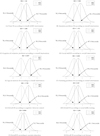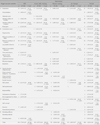Abstract
Purpose
The purpose of this study was to investigate the trends and the effects of intervention related to ADHD children by meta-analysis.
Methods
After review of 200 articles released from 1990 to 2009 from RISS, KISS, and DBpia, 26 studies was conducted to determine methodological data, 362 research variables, using SPSS/WIN 17.0 program.
Results
Effects size of overall intervention is 1.32 which is high level in terms of Cohen criteria. The greatest effect of intervention is obtained from cognitive behavior control training (1.79). Also art therapy (1.29) and social skill training (0.97) are highly effective whereas parents education (0.66) is only moderate effective. Duration of each session and numbers of session are influential in cognitive behavior control and social skills training.
Conclusion
The results reveal that ADHD intervention has large effect sizes for core features and peripheral features of target outcome variables. For improving the reliability of the meta-analysis results by minimizing publication bias, more intervention studies using appropriated study design should be done.
Figures and Tables
Table 2
Summary of Characteristics of ADHD Intervention Studies (N=26)

Intervention types: CBT=cognitive-behavioral control training; SST=social skill training; PTT=parenting training; ATT=art therapy training.
Target outcome variables: AP=attention problem; CBP=cognitive-behavioral problem; SSP=social skills problem; EEP=ego & emotion problem; RPP=related parenting problem.
References
1. Ahn DH. Attention deficit hyperactivity disorder (ADHD). In : Hong KE, editor. Korean textbook of children psychiatry. Seoul: Joongang Press;2006. p. 220–248.
2. Barkley RA. Attention deficit hyperactivity disorder. New York, NY: Duilford Press;1990.
3. Bor W, Sanders MR, Markie-Dadds C. The effects of the triple p-positive parenting program on preschool children with co-occurring disruptive behavior and attentional/hyperactive difficulties. J Abnorm Child Psychol. 2002; 30(6):571–587.
4. Cho SE. A meta-analysis on the efficacy of parent education programs for handicapped children in Korea. J Spec Educ:Theory Pract. 2004; 5(1):415–429.
5. Cohen J. Statistical power analysis for the behavioral science. 2nd ed. New York, NY: Academic Press;1988.
6. Corcoran J, Dattalo P. Parent involvement in treatment for ADHD: A meta-analysis of published studies. Res Soc Work Pract. 2006; 16:561–570.

7. Fabiano GA, Pelham WE, Coles EK, Gnagy EM, Chronis-Tuscano A, O'Connor BC. A meta-analysis of behavior treatments for attention-deficit/hyperactivity disorder. Clin Psychol Rev. 2009; 29:129–140.

8. Frankel F, Myatt R, Cantwell DP, Feinberg DT. Parent assisted transfer of children's social skills training: Effects on children with and without attention-deficit/hyperactivity disorder. J Am Acad Child Adolesc Psychiatry. 1997; 36:1056–1064.

9. Gresham FM, Cook CR, Crews SD, Kern L. Social skills training for children and youth with emotional and behavior disorder: Validity considerations and future directions. Behav Disord. 2004; 30:32–46.

10. Kim IH. Effect of the group art therapy in children with attention-deficit hyperactivity disorder (ADHD). J Korean Acad Psychiatr Ment Health Nurs. 2006; 15(2):152–160.
11. Kim IH. The effect of social skills training with attention-deficit hyperactivity disorder (ADHD). J Korean Acad Psychiatr Ment Health Nurs. 2007; 16(4):420–428.
12. Landahl B, Risser HJ, Lovejoy C. A meta-analysis of parent training: Moderators and follow-up effects. Clin Psychol Rev. 2005; 26:86–104.

13. Lee SS. A meta-analysis of the effect of art therapy programs on ADHD children's essential feature. Daegu: Daegu University;2008. Unpublished master's thesis.
14. Lee Y. A meta-analysis of the effect of group counseling programs on ADHD children's behavior change. Jeonju: Chungbuk National University;2006. Unpublished master's thesis.
15. Majewicz-Hefley A, Carlson JS. A meta-analysis of combined treatments for children diagnosed with ADHD. J Atten Disord. 2007; 10:239–250.

16. National Institute for Health and Clinical Excellence. Attention deficit hyperactivity disorder: Diagnosis and management of ADHD in children, young people and adults. 2009. 03. Retrieved October, 15, 2009. from NICE Web site: http://guidance.nice.org.uk/CG72/Guidance/pdf/English.
17. Selekman J, Moore CK. Attention deficit hyperactivity disorder. In : Allen PJ, Vessey JA, editors. Primary care of the child with a chronic condition. 4th ed. St. Louis, Missouri: Mosby;2004. p. 198–216.




 PDF
PDF ePub
ePub Citation
Citation Print
Print









 XML Download
XML Download